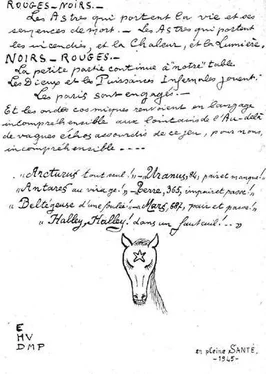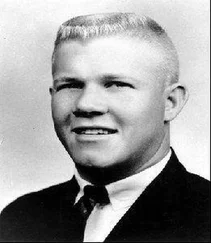According to Porchon, when he challenged this statement, Nézondet told him that he had entered a basement somewhere in town—he did not say where—and seen “sixteen corpses stretched out.” Porchon was still skeptical, he said, but Nézondet replied that he had seen the corpses himself. “They were completely black,” he added. “They must have died by injection or some poison.”
Nézondet then allegedly told Porchon why he thought Petiot had killed his victims: “I suppose he asked them for money to pass them into the Free Zone and instead of helping them escape, he killed them.” Nézondet swore Porchon to silence, assuring him that he would report the murders to the police himself as soon as the war ended.
As if that were not disturbing enough, Massu now learned that this was apparently not the first time Porchon had reported Petiot’s suspected murders to the police. On August 2, 1943, Porchon had contacted a friend, Commissaire Lucien Doulet, then a forty-two-year-old director of the police économique at the quai de Gesvres, which investigated financial crime, and told him about a rumor circulating in the underworld about “a Parisian doctor who, under the pretext of passing young people out of the country, asked them for sums of money between 50,000 and 75,000 francs, and then did away with them after payment.” This doctor, Porchon added, disposed of the remains “by burying them in the courtyard of his building.”
Doulet had told him to report the news to the Police Judiciaire, which Porchon did. “He didn’t seem to take the matter seriously,” Porchon said. The police officer in question, Massu learned, was an inspector on his own Brigade Criminelle: René Bouygues. When the commissaire interviewed him on August 19, Assistant Inspector Principal Bouygues admitted knowing Porchon for five years and praised him as a valued police informer. But he denied ever hearing anything about Petiot or any murders. He later changed his mind, saying that he had “forgotten about it.”
That Inspector Bouygues would attempt to make this excuse for not pursuing the allegation illustrates the sheer disregard for human life during the German Occupation—a time when many people simply disappeared without explanation. Porchon’s testimony also underlined the extent to which the police department, even when tipped off about possible murder, neglected to investigate. Was this an example of incompetence, an overwhelmed police force, or yet another sign that perhaps someone was protecting Marcel Petiot?
It was at this time that Massu learned that the rumors of a stranger arriving at and departing from the crime scene at rue Le Sueur on the night of March 11 were true. Patrolmen Teyssier and Fillion, the policemen who spoke with the man, had always denied it, persisting in their stance even after fireman Corporal Boudringhin gave his testimony on March 16, describing the visitor in detail.
Teyssier admitted that there had been many curious people outside the town house, but he said none had been allowed to enter. He flat-out denied the claims of the fire chief. “At no point,” Teyssier said, “have I seen Dr. Petiot on the premises.” Fillion supported Teyssier, but the evidence was mounting. Robert Bouquin, one of the first arrivals to rue Le Sueur, also saw the stranger, as did Maurice Choquat, who had arrived that night about 7:45.
On March 18, 1944, Patrolmen Teyssier and Fillion reversed themselves. A man claiming to be “the brother of the owner,” Fillion confessed, had approached him and entered the building with his permission. He explained this lapse of judgment by the fact that he had been shocked and overwhelmed by the “staggering spectacle and the unbreathable air from the smell of rotting cadavers burning in the stove.” Teyssier also now acknowledged seeing the stranger. After his return from calling headquarters for reinforcement, Teyssier noticed this unknown man standing under the vault of the carriage entrance with Fire Chief Boudringhin and Fillion, the latter looking uncomfortable. The man had remained three or four minutes, Fillion said, and then left, profiting from the general chaos. “At that moment,” Fillion added, “I was far from thinking that this man was the killer.”
For this negligence of duty, as well as their repeated lies, Patrolmen Teyssier and Fillion were removed from their positions and ordered to appear before the Germans at the Pépinière Armory. Both men fled, fearing severe reprisals. Teyssier, a thirty-nine-year-old member of a Resistance group inside the police—l’Honneur de la police—escaped by jumping out of a window at the armory.
14.
DESTINATION ARGENTINA
IF THE AMOUNT OF DOUGH EDITH DONATED FOR ALL THESE GOOD CAUSES IS ANY INDICATION, SMUGGLING PEOPLE ACROSS THE BORDER WAS A GREAT WAY TO MAKE A LIVING.
—Simone Berteaut, on her sister Edith Piaf
ON the evening of March 19, 1944, Pablo Picasso’s play Le Désir attrapé par la queue (Desire Caught by the Tail) was performed in private at his friends Michel and Zette Leiris’s fifth-floor apartment on the Quai des Grands-Augustins. It was a dark surrealist farce that featured a star-studded cast: Jean-Paul Sartre, Simone de Beauvoir, and Picasso’s former lover Dora Maar. Albert Camus narrated, describing the largely imaginary sets—that is, except for a large black box that served alternatively as a bed, a bathtub, and a coffin.
Picasso had written the play three years earlier, beginning, as he recorded in a notebook, on the evening of January 14, 1941, and, in the tradition of surrealist automatic writing, finishing it three days later. Reminiscent of 1920s avant-garde theater, the play revolved around deprivation and indulgence, or more specifically hunger and sex. Michel Leiris, who had selected the cast, played the lead role of Big Foot. Sartre was The Round End; Raymond Queneau, The Onion; and Jacques-Laurent Bost, Silence. Simone de Beauvoir played The Cousin, while publisher Jean Aubier was The Curtains.
When Gertrude Stein had read the script, she suggested that Picasso stick to painting. But the photographer Gyula Halász, better known as Brassaï, after his native Transylvanian village of Brassó, thought otherwise. He praised Picasso’s virtuosity, comparing the composition style to a “verbal trance [that] gave free rein to dreams, obsessions, unavowed desires, comical connections between ideas and words, everyday banalities, the absurd.” This play, he added, displayed the painter’s “humor and inexhaustible spirit of invention … in their pure state.”
The audience, filled with painters, writers, playwrights, surrealists, and even Argentine millionaires, seemed to agree. They applauded loudly and congratulated Picasso on his success. Afterward, the cast and audience retired for a celebration, fueled by wine and desserts, including a chocolate cake brought by the Argentines.
As the play ended at about eleven, just before that night’s curfew, Leiris had invited the cast and several friends to stay the night. They sang, listened to jazz records, and admired Sartre playing the piano. Camus and the host acted out various scenes, enhanced in part with wine served warm with cinnamon. The party ended at five in the morning. Simone de Beauvoir was overjoyed: “A year before we would never have dreamed of gathering together like this and having a noisy, frivolous party that went on for hours.”
This was the first of the fiestas, as Michel Leiris dubbed them, that would take place in the spring of 1944. Beauvoir described another one not long afterward, at surrealist Georges Bataille’s house in the Cour de Rohan:
We constituted a sort of carnival with its mountebanks, its confidence men, its clowns, and its parades. Dora Marr used to mime a bullfighting act; Sartre conducted an orchestra from the bottom of a cupboard; Limbour carved up a ham as though he were a cannibal: Queneau and Bataille fought a duel with bottles instead of swords; Camus and Lemarchend played military marches on saucepan lids, while those who knew how to sing, sang. So did those who didn’t. We had pantomimes, comedies, diatribes, parodies, monologues, and confessions: the flow of improvisations never dried up, and they were always greeted with enthusiastic applause. We put on records and danced; some of us … very well; others less expertly
Читать дальше












